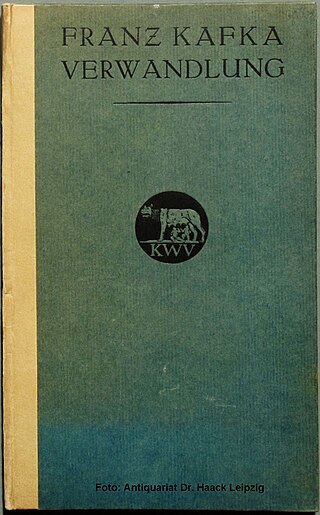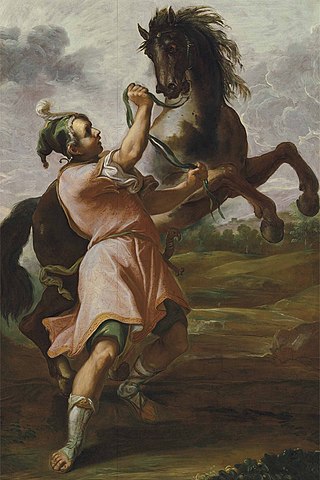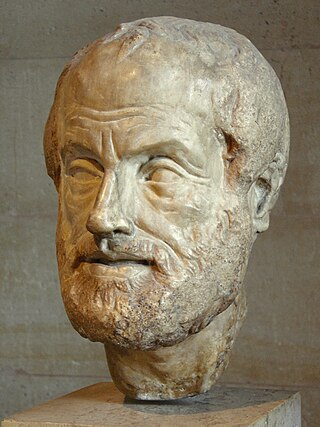
Metamorphosis is a novella written by Franz Kafka which was first published in 1915. One of Kafka's best-known works, Metamorphosis tells the story of salesman Gregor Samsa, who wakes one morning to find himself inexplicably transformed into a huge insect and subsequently struggles to adjust to this new condition. The novella has been widely discussed among literary critics, with differing interpretations being offered. In popular culture and adaptations of the novella, the insect is commonly depicted as a cockroach.

Bucephalus or Bucephalas was the horse of Alexander the Great, and one of the most famous horses of classical antiquity.
In literature and writing, stylistically elements are the use of any of a variety of techniques to give an auxiliary meaning, ideas, or feeling to the literalism or written.

The Castle is the last novel by Franz Kafka. In it a protagonist known only as "K." arrives in a village and struggles to gain access to the mysterious authorities who govern it from a castle supposedly owned by Count Westwest.

"The Judgment", also translated "The Verdict", is a short story written by Franz Kafka in 1912, concerning the relationship between a man and his father.
"A Report to an Academy" is a short story by Franz Kafka, written and published in 1917. In the story, an ape named Red Peter, who has learned to behave like a human, presents to an academy the story of how he effected his transformation. The story was first published by Martin Buber in the German monthly Der Jude, along with another of Kafka's stories, "Jackals and Arabs". The story appeared again in a 1919 collection titled Ein Landarzt.

Kafka on the Shore is a 2002 novel by Japanese author Haruki Murakami. Its 2005 English translation was among "The 10 Best Books of 2005" from The New York Times and received the World Fantasy Award for 2006. The book tells the stories of the young Kafka Tamura, a bookish 15-year-old boy who runs away from his Oedipal curse, and Satoru Nakata, an old, disabled man with the uncanny ability to talk to cats. The book incorporates themes of music as a communicative conduit, metaphysics, dreams, fate, the subconscious.

Representation is the use of signs that stand in for and take the place of something else. It is through representation that people organize the world and reality through the act of naming its elements. Signs are arranged in order to form semantic constructions and express relations.

"Dagon" is a short story by American author H. P. Lovecraft. It was written in July 1917 and is one of the first stories that Lovecraft wrote as an adult. It was first published in the November 1919 edition of The Vagrant. Dagon was later published in Weird Tales in October 1923. It is considered by many to be one of Lovecraft's most forward-looking stories.
"The Burrow" is an unfinished short story by Franz Kafka written six months before his death. In the story a badger-like creature struggles to secure the labyrinthine burrow he has excavated as a home. The story was published posthumously in Beim Bau der Chinesischen Mauer by Max Brod, Kafka's friend and literary executor. The first English translation, by Willa and Edwin Muir, was published by Martin Secker in London in 1933. It appeared in The Great Wall of China. Stories and Reflections.
"Josephine the Singer, or the Mouse Folk" is the last short story written by Franz Kafka. It deals with the relationship between an artist and her audience. The story was included in the collection A Hunger Artist published by Verlag Die Schmiede soon after Kafka's death.

Betrachtung is a collection of eighteen short stories by Franz Kafka written between 1904 and 1912. It was Kafka's first published book, printed at the end of 1912 in the Rowohlt Verlag on an initiative by Kurt Wolff.

Spool knitting,corking,French knitting or tomboy knitting is a form of knitting that uses a spool with a number of nails or pegs around the rim to produce a tube or sheet of fabric. The spool knitting devices are called knitting spools, knitting nancys, knitting frame, or French knitters.

Franz Kafka, a German-language writer of novels and short stories who is regarded by critics as one of the most influential authors of the 20th century, was trained as a lawyer and later employed by an insurance company, writing only in his spare time.

"Up in the Gallery" is a short piece of fiction written by Franz Kafka. It was created between November 1916 and February 1917 and published in the collection Ein Landarzt in 1919. The story offers two versions of a scene in which a young man watches a circus ringmaster and a woman on horseback.
"The Bucket Rider" is a short story by Franz Kafka, written in 1917. It first appeared in the Prager Presse in 1921 and was published posthumously in Beim Bau der Chinesischen Mauer. The first English translation, by Willa and Edwin Muir, was published by Martin Secker in London in 1933. It also appeared in The Great Wall of China. Stories and Reflections.

Odradek Records is a cooperative, non-profit record label that releases recordings of classical music.

A Country Doctor is a collection of short stories written mostly in 1917 by Franz Kafka, containing the story of the same name. Kurt Wolff published it in 1919 as the second collection of stories by Kafka, after Betrachtung.
Odradek is a creature in Franz Kafka's The Cares of a Family Man.

Ein Landarzt is a one-act chamber opera composed by Hans Werner Henze. The libretto was written by Henze and is closely based on Kafka's 1917 short story "Ein Landarzt". The work was originally composed as a radio opera and was premiered on 19 November 1951 in a broadcast by Nordwestdeutscher Rundfunk. Henze subsequently revised the work in 1964 both as a monodrama for baritone and chamber orchestra and as a one-act staged opera. The stage version was premiered by the Oper Frankfurt on 30 November 1965.













